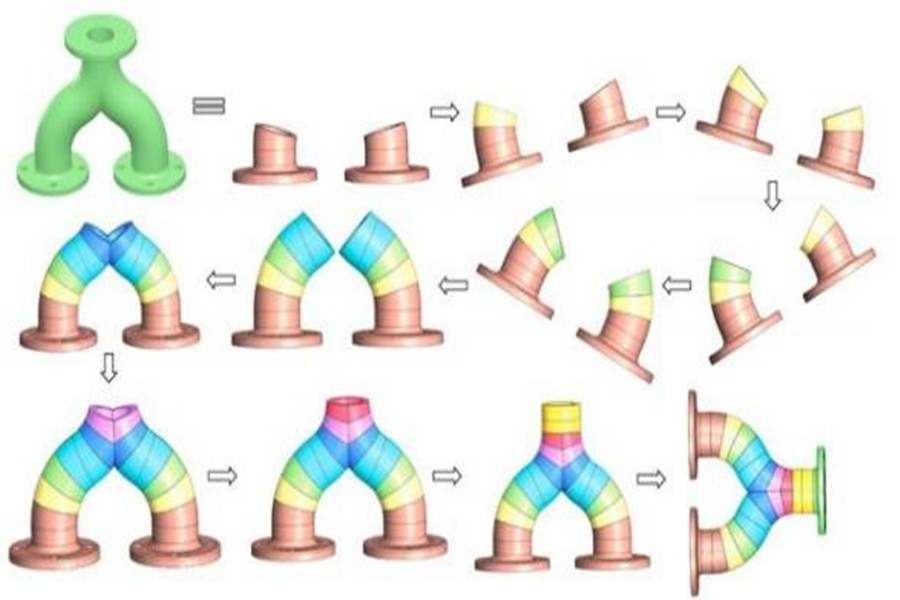In the field of additive manufacturing, most equipment still uses traditional 3-axis machine tools. Although 5-axis machine tools can print complex geometric shapes, the existing equipment still needs to print support structures.

If there is no support, less materials will be used and the machine will spend less time for active printing, thus saving a lot of time and cost. Unfortunately, the software to implement the corresponding functions is still lacking. Recently, researchers from Pennsylvania State University in the United States have developed process software specifically for 5-axis machine tools, which automates the decision-making process involved in additive manufacturing through the algorithm-driven automatic slicing process.
Unsupported 3D printed part breakdown area
The software works by determining the various parts of the part and its orientation, so that its algorithm can determine which part of the part is to be printed first and at which angle. Through this decomposition process, the geometric shape of the part is decomposed into individual blocks, so that each block can be printed on top of the previous block without any support structure. When each part is printed in a predetermined order, the build board is reoriented to set the next step in the same order as the process of building with Lego bricks.
3D component decomposition steps
Of course, if there is no support structure, there will be geometric shapes that cannot be printed. In these cases, the algorithm can inform users of the feasibility of their design, allowing designers to make corrections and modify their geometry before printing-thus further saving costs.
Joshi, one of the research members, explained: “With an algorithm, you really don’t need the user’s expertise because it is in the software. Automation can help you quickly try many different solutions before you create anything on the computer.”
Since the team’s main application areas are aerospace and automotive, the main research institute Xiao has stated that it plans to further develop research suitable for industrial metal 3D printing systems. She concluded: “Large metal parts using traditional additive manufacturing technology may take several days, and a lot of material is wasted by using support structures. Additive manufacturing is very powerful, and because of its flexibility, many things can be manufactured. . However, it also has shortcomings. There is more work to be done.”
Link to this article: New 5-axis 3D printing software saves costs
Reprint Statement: If there are no special instructions, all articles on this site are original. Please indicate the source for reprinting:https://www.cncmachiningptj.com/,thanks!
 PTJ® provides a full range of Custom Precision cnc machining china services.ISO 9001:2015 &AS-9100 certified. Large scale machining Manufacturer of medical bags, providing 3D design, prototype and global delivery services. Also offering hard cases, semi-hard EVA, soft-sewn cases, pouches and more for OEMs. All cases are made custom according to specifications with infinite combinations of materials, molds, pockets, loops, zippers, handles, logos and accessories. Shockproof, water-resistant and eco-friendly options. Medical parts, emergency response, Electronic parts, corporate, education, military, security, sports, outdoors and construction industries. Services include case concept consultation, 3D design, prototyping,rototyping,CNC Drilling Services and manufacturing.Tell us a little about your project’s budget and expected delivery time. We will strategize with you to provide the most cost-effective services to help you reach your target,You are welcome to contact us directly ( [email protected] ) .
PTJ® provides a full range of Custom Precision cnc machining china services.ISO 9001:2015 &AS-9100 certified. Large scale machining Manufacturer of medical bags, providing 3D design, prototype and global delivery services. Also offering hard cases, semi-hard EVA, soft-sewn cases, pouches and more for OEMs. All cases are made custom according to specifications with infinite combinations of materials, molds, pockets, loops, zippers, handles, logos and accessories. Shockproof, water-resistant and eco-friendly options. Medical parts, emergency response, Electronic parts, corporate, education, military, security, sports, outdoors and construction industries. Services include case concept consultation, 3D design, prototyping,rototyping,CNC Drilling Services and manufacturing.Tell us a little about your project’s budget and expected delivery time. We will strategize with you to provide the most cost-effective services to help you reach your target,You are welcome to contact us directly ( [email protected] ) .
Link to this article:New 5-axis 3D printing software saves costs
Reprint Statement: If there are no special instructions, all articles on this site are original. Please indicate the source for reprinting.:Cut Wiki,Thanks!^^
